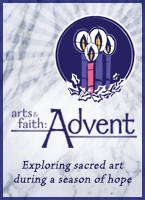Arts & Faith: Your Christmas Reflection, Cycle C
John Singleton Copley, “The Nativity,” 1777

John Singleton Copley’s The Nativity offers a glimpse of the Holy Family through the lens of American colonial portrait painting. Copley was famous for capturing the idealized character of his subjects, often through attention to specific details, textures, and props. In this image, Mary, Joseph, and the infant Jesus are surrounded by shepherds and some animals, all coming to pay homage to the newborn child.
Interestingly, the scene is largely devoid of supernatural elements. There are no angels, no star, and no halos on the Holy Family. A bright light illuminating the scene from the top left, guiding the eye toward Mary and the child, is our only explicit indication that this an extraordinary birth that has brought the world its Savior. This light recalls the glory of the Lord shining on the shepherds in Luke’s Gospel. The light here points the shepherds directly to the Christ child. Bathed in the light, the shepherds are reverent and in awe.
Without the traditional symbols of the supernatural, Copley’s stylized depiction of Mary and the child communicate the birth of the Savior in another way. In the midst of an ordinary stable, on top of hay and a wool blanket, and surrounded by animals and shepherds, Mary lays in a classical pose on a pristine white sheet, gazing at her son who is resting on a soft white pillow. The beauty and immaculate setting tell us about the extraordinariness of this event. As compared to the other figures of the scene, Mary and the child receive the most attention from Copley as a portrait artist. Clad in bright white, Mary is like royalty, radiating grace as she gazes at Jesus. Mary and Jesus’ immaculate presence contrasts with the roughness of the wool and hay, the sheepdog and the oxen, and the brightly clad shepherds surrounding them. In this, Copley offers us a visual reflection on the mystery of the Son of God taking on our messy, human flesh while remaining fully God. Mary seems to be pondering this mystery as well.
In the background, instead of a star, we spot the full moon, reflected serenely in a body of water. All is calm and bright on this holy night, as we behold the mystery that has come to meet us.

Commentary is by Daniella Zsupan-Jerome, director of ministerial formation at Saint John's University School of Theology and Seminary.
Related Ignatian reflection on this week’s art
Your Christmas Reflection, Cycle C

Christmas Carols (Ages 9–14)
Have the young people study the lyrics of popular traditional Christmas carols and compare them with The Nativity as depicted by John Singleton Copley and the Gospel story in Luke chapter 2. Include favorites such as “Silent Night,” “The First Noel,” and “Angels We Have Heard on High.” After a discussion, lead a Christmas carol sing-a-long.
Born in Difficult Circumstances (Ages 11–15)
Our familiarity with the Christmas story sometimes makes us forget about the difficult circumstances surrounding Jesus’ birth. Focus attention on Copley’s painting or a nativity set you have displayed in the room. Recall that Jesus was born in a stable. The animals might have been noisy and may even have smelled unpleasant. Joseph and Mary were far from home in a city that was crowded and under the occupation of foreigners. The shepherds may have been unclean from their time in the fields. Invite young people to say one thing about the Christmas story that makes an impression upon them. Conclude by praying together for people today who may experience circumstances like those found in the story of Jesus’ birth. Pray for those who are far from home, those who live in fear, and those who live in need.

